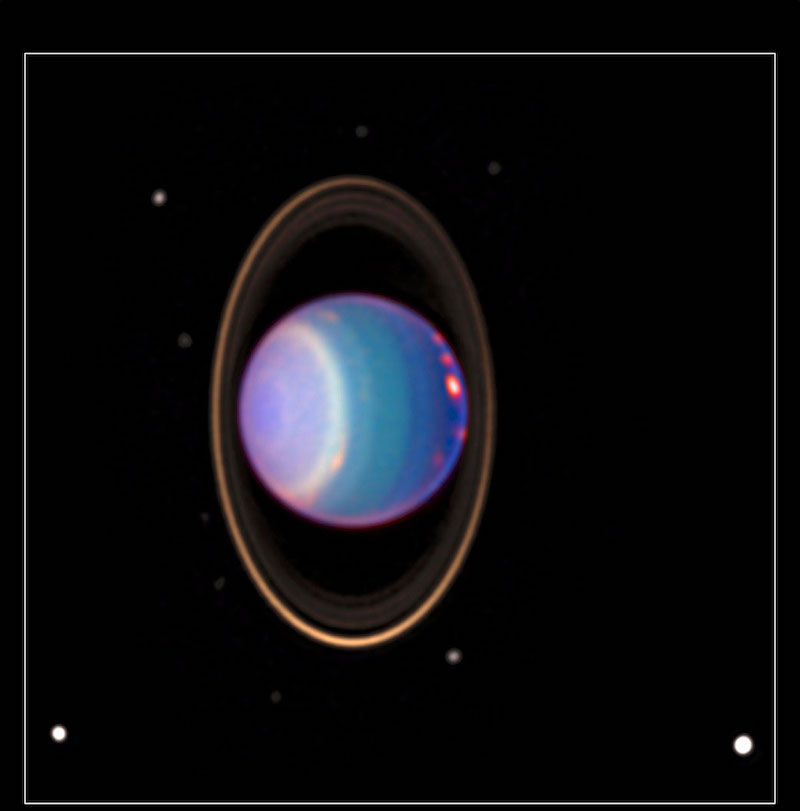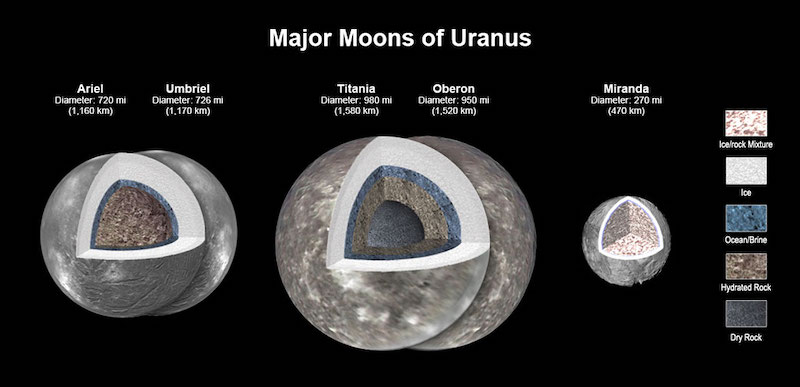
Oceans for 4 Uranus moons?
Jupiter’s moon Europa and Saturn’s moon Enceladus both are thought to have a liquid water ocean beneath an outer icy crust. Neptune’s largest moon, Triton, might also have a subsurface ocean. But what about Uranus? Are any of its moons ocean worlds? On May 4, 2023, several researchers across the U.S. announced that at least four of Uranus’ moons do have oceans of their own.
The researchers first published their peer-reviewed paper on December 14, 2022 in JGR Planets. They later re-published it with a correction on February 6, 2023.
Re-analyzing data from Voyager 2
The research team re-analyzed data from the old NASA Voyager 2 mission, which flew past Uranus on January 24, 1986. They applied new computer modeling to the data and found that four of Uranus’ largest moons – Ariel, Umbriel, Titania and Oberon – likely have an ocean layer deep inside them. The oceans, between the cores and outer crusts of the moons, are estimated to be up to dozens of miles deep. The paper says:
The major moons of Uranus, Miranda, Ariel, Umbriel, Titania and Oberon, are interesting targets for a future space mission because they might host liquid at present. Studying these bodies would help address the extent of habitable environments in the outer solar system. We model their thermal, physical and chemical evolution. Because their heat budget is limited, with little or no tidal heating at present, we find that most of the moons can preserve only a few tens of kilometers of liquid until present.
The computer models used additional findings from NASA’s Galileo, Cassini, Dawn and New Horizons missions. This includes the chemistry and geology of Saturn’s moon Enceladus, Pluto and its moons Charon and Ceres. All of these icy bodies are about the same size as the four Uranian moons, and are known or suspected to have subsurface oceans. Lead author Julie Castillo-Rogez of NASA’s Jet Propulsion Laboratory stated:
When it comes to small bodies – dwarf planets and moons – planetary scientists previously have found evidence of oceans in several unlikely places, including the dwarf planets Ceres and Pluto, and Saturn’s moon Mimas. So there are mechanisms at play that we don’t fully understand. This paper investigates what those could be and how they are relevant to the many bodies in the solar system that could be rich in water but have limited internal heat.
Heat and antifreeze keep oceans liquid on Uranus’ largest moons
How could these cold, icy and rocky bodies have liquid water inside them? Especially being so far from the sun? The answer is the same as for the other ocean moons and dwarf planets: internal heat. The new modeling showed that the moons’ surfaces are insulated enough to maintain some internal heat inside the moons. There may also be another heat source within the mantles of the moons. That heat source could release hot liquid. Overall, this should be enough heat to keep the oceans warm, in particular on Titania and Oberon.
Scientists have also previously seen possible evidence of icy volcanoes on Ariel, where liquid water and other material flowed onto the surface before freezing. The paper explains:
Ariel is particularly interesting as a future mission target because of the potential detection of NH3-bearing species on its surface (Cartwright et al., 2021) that could be evidence of recent cryovolcanic activity, considering these species should degrade on a geologically short timescale. Geologic features, visible in Voyager 2 Imaging Science Subsystem images of Ariel, show some evidence for cryovolcanism in the form of double ridges and lobate features that may represent emplaced cryolava (Beddingfield & Cartwright, 2021).
The results also suggest that heat alone isn’t keeping the moons’ oceans liquid. Chlorides, ammonia and salts also likely play a role, acting as a natural antifreeze.

Miranda used to be an ocean moon too
A fifth moon, Miranda, also displays surface features consistent with a subsurface ocean, but in the past. The modeling suggests that Miranda, the fifth-largest moon, is too small to have retained enough heat for an ocean in the present day. Therefore, its ocean is probably frozen solid now. As the paper states:
Despite its intriguing geology and candidate ocean world categorization by Hendrix et al. (2019), this study could not find scenarios that would preserve a deep ocean in that moon until present.
A new future mission to Uranus will be needed to determine more about the conditions in these alien oceans, and whether any of them might be habitable. Spectrometers on the spacecraft could study compounds such as ammonia and chlorides by analyzing the subsurface oceans with a wavelength that can detect them. The spectrometers could also look for electrical currents in the oceans.
Such a mission is still a long way off, but it would be exciting, wouldn’t it? Voyager 2 is still the last mission to ever visit Uranus, in 1986. A Uranus Orbiter and Probe mission has been proposed, although as of now it is still on the drawing board, and likely wouldn’t launch until the mid-late 2030s. It would study both Uranus and its moons in-depth.
Uranus has 27 known moons. The largest is Titania, at 980 miles (1,580 km) in diameter. All of them are named for characters in the works of Shakespeare and Alexander Pope.
Bottom line: A new study suggests oceans for four of Uranus’ moons. If true, they’d join a growing number of ocean worlds in the outer part of our solar system.
The post Oceans for 4 Uranus moons likely, astronomers say first appeared on EarthSky.
from EarthSky https://ift.tt/Us4Zo6Q

Oceans for 4 Uranus moons?
Jupiter’s moon Europa and Saturn’s moon Enceladus both are thought to have a liquid water ocean beneath an outer icy crust. Neptune’s largest moon, Triton, might also have a subsurface ocean. But what about Uranus? Are any of its moons ocean worlds? On May 4, 2023, several researchers across the U.S. announced that at least four of Uranus’ moons do have oceans of their own.
The researchers first published their peer-reviewed paper on December 14, 2022 in JGR Planets. They later re-published it with a correction on February 6, 2023.
Re-analyzing data from Voyager 2
The research team re-analyzed data from the old NASA Voyager 2 mission, which flew past Uranus on January 24, 1986. They applied new computer modeling to the data and found that four of Uranus’ largest moons – Ariel, Umbriel, Titania and Oberon – likely have an ocean layer deep inside them. The oceans, between the cores and outer crusts of the moons, are estimated to be up to dozens of miles deep. The paper says:
The major moons of Uranus, Miranda, Ariel, Umbriel, Titania and Oberon, are interesting targets for a future space mission because they might host liquid at present. Studying these bodies would help address the extent of habitable environments in the outer solar system. We model their thermal, physical and chemical evolution. Because their heat budget is limited, with little or no tidal heating at present, we find that most of the moons can preserve only a few tens of kilometers of liquid until present.
The computer models used additional findings from NASA’s Galileo, Cassini, Dawn and New Horizons missions. This includes the chemistry and geology of Saturn’s moon Enceladus, Pluto and its moons Charon and Ceres. All of these icy bodies are about the same size as the four Uranian moons, and are known or suspected to have subsurface oceans. Lead author Julie Castillo-Rogez of NASA’s Jet Propulsion Laboratory stated:
When it comes to small bodies – dwarf planets and moons – planetary scientists previously have found evidence of oceans in several unlikely places, including the dwarf planets Ceres and Pluto, and Saturn’s moon Mimas. So there are mechanisms at play that we don’t fully understand. This paper investigates what those could be and how they are relevant to the many bodies in the solar system that could be rich in water but have limited internal heat.
Heat and antifreeze keep oceans liquid on Uranus’ largest moons
How could these cold, icy and rocky bodies have liquid water inside them? Especially being so far from the sun? The answer is the same as for the other ocean moons and dwarf planets: internal heat. The new modeling showed that the moons’ surfaces are insulated enough to maintain some internal heat inside the moons. There may also be another heat source within the mantles of the moons. That heat source could release hot liquid. Overall, this should be enough heat to keep the oceans warm, in particular on Titania and Oberon.
Scientists have also previously seen possible evidence of icy volcanoes on Ariel, where liquid water and other material flowed onto the surface before freezing. The paper explains:
Ariel is particularly interesting as a future mission target because of the potential detection of NH3-bearing species on its surface (Cartwright et al., 2021) that could be evidence of recent cryovolcanic activity, considering these species should degrade on a geologically short timescale. Geologic features, visible in Voyager 2 Imaging Science Subsystem images of Ariel, show some evidence for cryovolcanism in the form of double ridges and lobate features that may represent emplaced cryolava (Beddingfield & Cartwright, 2021).
The results also suggest that heat alone isn’t keeping the moons’ oceans liquid. Chlorides, ammonia and salts also likely play a role, acting as a natural antifreeze.

Miranda used to be an ocean moon too
A fifth moon, Miranda, also displays surface features consistent with a subsurface ocean, but in the past. The modeling suggests that Miranda, the fifth-largest moon, is too small to have retained enough heat for an ocean in the present day. Therefore, its ocean is probably frozen solid now. As the paper states:
Despite its intriguing geology and candidate ocean world categorization by Hendrix et al. (2019), this study could not find scenarios that would preserve a deep ocean in that moon until present.
A new future mission to Uranus will be needed to determine more about the conditions in these alien oceans, and whether any of them might be habitable. Spectrometers on the spacecraft could study compounds such as ammonia and chlorides by analyzing the subsurface oceans with a wavelength that can detect them. The spectrometers could also look for electrical currents in the oceans.
Such a mission is still a long way off, but it would be exciting, wouldn’t it? Voyager 2 is still the last mission to ever visit Uranus, in 1986. A Uranus Orbiter and Probe mission has been proposed, although as of now it is still on the drawing board, and likely wouldn’t launch until the mid-late 2030s. It would study both Uranus and its moons in-depth.
Uranus has 27 known moons. The largest is Titania, at 980 miles (1,580 km) in diameter. All of them are named for characters in the works of Shakespeare and Alexander Pope.
Bottom line: A new study suggests oceans for four of Uranus’ moons. If true, they’d join a growing number of ocean worlds in the outer part of our solar system.
The post Oceans for 4 Uranus moons likely, astronomers say first appeared on EarthSky.
from EarthSky https://ift.tt/Us4Zo6Q

Aucun commentaire:
Enregistrer un commentaire